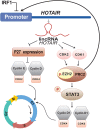The emerging role of the long non-coding RNA HOTAIR in breast cancer development and treatment
- PMID: 32245498
- PMCID: PMC7119166
- DOI: 10.1186/s12967-020-02320-0
The emerging role of the long non-coding RNA HOTAIR in breast cancer development and treatment
Abstract
Despite considering vast majority of the transcribed molecules as merely noise RNA in the last decades, recent advances in the field of molecular biology revealed the mysterious role of long non-coding RNAs (lncRNAs), as a massive part of functional non-protein-coding RNAs. As a crucial lncRNA, HOX antisense intergenic RNA (HOTAIR) has been shown to participate in different processes of normal cell development. Aberrant overexpression of this lncRNA contributes to breast cancer progression, through different molecular mechanisms. In this review, we briefly discuss the structure of HOTAIR in the context of genome and impact of this lncRNA on normal human development. We subsequently summarize the potential role of HOTAIR overexpression on different processes of breast cancer development. Ultimately, the relationship of this lncRNA with different therapeutic approaches is discussed.
Keywords: Breast cancer; HOTAIR; Normal development; Therapeutic approaches; lncRNA.
Conflict of interest statement
Authors declare no conflict of interest.
Figures




Similar articles
-
Antisense transcript long noncoding RNA (lncRNA) HOTAIR is transcriptionally induced by estradiol.J Mol Biol. 2013 Oct 9;425(19):3707-22. doi: 10.1016/j.jmb.2013.01.022. Epub 2013 Jan 31. J Mol Biol. 2013. PMID: 23375982 Free PMC article.
-
Long non-coding RNA HOTAIR in carcinogenesis and metastasis.Acta Biochim Biophys Sin (Shanghai). 2014 Jan;46(1):1-5. doi: 10.1093/abbs/gmt117. Epub 2013 Oct 27. Acta Biochim Biophys Sin (Shanghai). 2014. PMID: 24165275 Free PMC article. Review.
-
Large intervening non-coding RNA HOTAIR is an indicator of poor prognosis and a therapeutic target in human cancers.Int J Mol Sci. 2014 Oct 20;15(10):18985-99. doi: 10.3390/ijms151018985. Int J Mol Sci. 2014. PMID: 25334066 Free PMC article. Review.
-
Estradiol-Induced Transcriptional Regulation of Long Non-Coding RNA, HOTAIR.Methods Mol Biol. 2016;1366:395-412. doi: 10.1007/978-1-4939-3127-9_31. Methods Mol Biol. 2016. PMID: 26585152
-
Knockdown of lncRNA HOTAIR sensitizes breast cancer cells to ionizing radiation through activating miR-218.Biosci Rep. 2019 Apr 5;39(4):BSR20181038. doi: 10.1042/BSR20181038. Print 2019 Apr 30. Biosci Rep. 2019. PMID: 30429228 Free PMC article.
Cited by
-
The Role of Non-Coding RNAs as Prognostic Factor, Predictor of Drug Response or Resistance and Pharmacological Targets, in the Cutaneous Squamous Cell Carcinoma.Cancers (Basel). 2020 Sep 8;12(9):2552. doi: 10.3390/cancers12092552. Cancers (Basel). 2020. PMID: 32911687 Free PMC article. Review.
-
Long non-coding RNAs in cancer: multifaceted roles and potential targets for immunotherapy.Mol Cell Biochem. 2024 Dec;479(12):3229-3254. doi: 10.1007/s11010-024-04933-1. Epub 2024 Feb 28. Mol Cell Biochem. 2024. PMID: 38413478 Review.
-
Next-Generation Sequencing Technology: Current Trends and Advancements.Biology (Basel). 2023 Jul 13;12(7):997. doi: 10.3390/biology12070997. Biology (Basel). 2023. PMID: 37508427 Free PMC article. Review.
-
Long Noncoding RNAs-Crucial Players Organizing the Landscape of the Neuronal Nucleus.Int J Mol Sci. 2021 Mar 27;22(7):3478. doi: 10.3390/ijms22073478. Int J Mol Sci. 2021. PMID: 33801737 Free PMC article. Review.
-
Metformin and long non-coding RNAs in breast cancer.J Transl Med. 2023 Feb 27;21(1):155. doi: 10.1186/s12967-023-03909-x. J Transl Med. 2023. PMID: 36849958 Free PMC article. Review.
References
Publication types
MeSH terms
Substances
LinkOut - more resources
Full Text Sources
Medical
Research Materials

